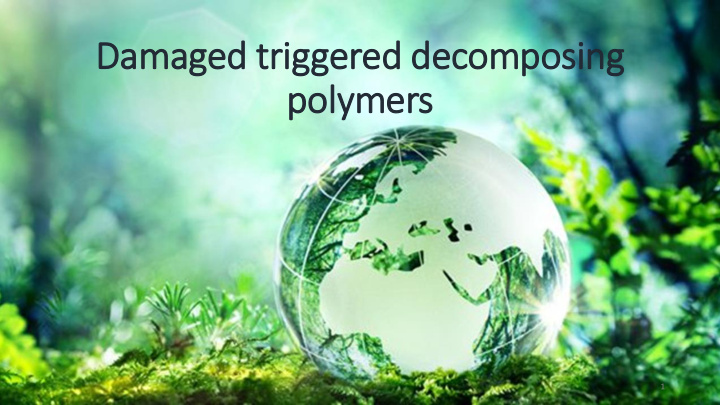



Damaged trigg iggered decomposing polymers 1
Problems: • Pollution. • Degradation. 2/14
What is our target? • From: Linear Economy to Circular Economy. • Enzymes. 3/14
Enzymes: Wax moth caterpillars: Mealworms: • EC1: oxidoreductase • Citrobacter sp. • Kosakonia sp. Anja Malawi Brandon • Polymer diet(32 days): 4/14 Malawi et al. . In Environ. Sci. Technol. 52 (11), pp. 6526 – 6533. 2018
Enzyme amount needed: • Current LDPE price = € 0,60 per kilo • Enzyme activity = 5U = 5 (micromoles/ min)/ mg enzyme • For 1 kilo LDPE: - 162 months needed if 1 mg enzyme - 0,2 gram needed for 1 month • In optimized process 1kg enzymes = € 10, - • If enzymes added € 0,60 → € 0,61 /14 5
Ensilication The fight against denature Si(OC 2 H 5 ) 4 + 2 H 2 O → SiO 2 + 4 C 2 H 5 OH Silica precursor (TEOS) Embodied silica- enzyme granule 6/14
The advantages of enzyme ensilication High efficiency After ensilication treatment • 100 mg enzyme with 80 mg silica Cheap • Ensilication of 2g enzyme costs 1.2 cent (TEOS € 60 per liter ) • Processable 200 nm globular particles • Storage and processing: RT 6 months; 100 ℃ 5 h Active • Release enzyme by NaF buffer pH=4, e.g. acidic soils 7/14 Chen et. al. Scientific reports , 7 , 46568. 2017
Global flows of plastic packaging materials in 2013 www.newplasticseconomy.org 8/14
World demand and application of PE in 2016 2016 total world PE demand is 92 million metric tons. 12% 9% 17% http://www.pttpm.com/ 9/14
10/14
Business model PE composite producing & PE producing Services: 1. Soil treatment 2. Water treatment Other application: Films for PEase agricultural usage & Enzyme ensilication technique Leakage from PE from waste the loop stream LDPE recycling Self-degrade 11/14
Life Cycle Assessment • 1 kg of LDPE needs 1.04 kg of raw materials. • Film production: 2000 USD per ton (€ 1,75 per kilo) • 3 kg of CO2 eq. are emitted. • 97.5% of total production ends to landfill. • 60 g of microplastic/kg.year. 12/14
Environmental Impact of Enzyme Ensilication in LDPE • … Enzymes requiered to degrade … LDPE in … time • 60 g/kg*a of LDPE get released → Released microplastic can be degraded → LCA to evaluate end-of-life • Application fields: → Treatment of contaminated biological waste/ landfills → Agricultural foil/ films with encapsulated enzymes 13/14
SWOT S W • • Reduce plastic polution Stability and activity of enzymes • • Fast degradation of LDPE Processing costs • • LDPE degrades into soil Uncertainty of product performance • • Ensilication preserves activity of enzemes Processing know-how O T • • Circular economy Unpredictable environmental effect of enzymes • Limit the plastic leakage into nature and silica • • Versatile applications (agriculture, packeging) Competition with fossil based products • Possibility of industrial or household composting • Desing of specifid enzymes
Questions ? /15 15
Recommend
More recommend